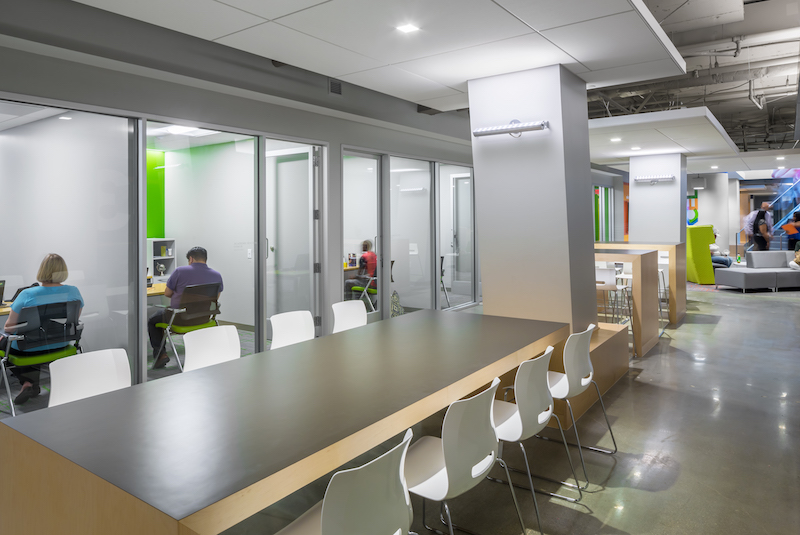About 63,000 adults in Washington D.C.—10% of the area’s adult population—lack high school diplomas. And these are the adults whom the Goodwill Excel Center, this market’s first adult charter high school, hopes to bring back to the educational fold.
Goodwill Industries of Greater Washington opened its first Excel Center in August inside a two-level, 21,500-sf basement space on G Street near the Old Executive Building. Goodwill received 2,055 applications for the 325 seats available. Three quarters of the students in its first class are women, and the ages of the students range from 26 to 39 years old. Seventy percent live in Wards 7 and 8, among D.C.’s poorest.
The D.C. school models itself after the first Excel Center in Indianapolis, which opened in 2010. There are now 11 Excel Centers in central Indiana, as well as in Memphis, Austin, Little Rock, Ark., and South Bend, Ind.
Catherine Meloy, CEO of Goodwill of Greater Washington, says her branch saw the need for an Excel Center after learning that many of the 2,000 applicants for jobs at D.C.’s Marriott Marquis hotel were turned away because their hadn’t graduated from high school. Several others who had a diploma weren’t hired because they couldn’t pass Marriott’s reading and math tests.
The Goodwill Excel Center operates five eight-week terms annually, and estimates it will take most students about two years to complete their education and earn a diploma. Meloy says that some of curricula are dual credited with a local college, and graduates will be credentialed in one of five industries: hospitality, security, healthcare, technology, or energy/utilities.
Beth Buffington, NCARB, LEED AP BD+C, Studio Principal with Little Community Group—which provided interior architecture, sustainable design, and brand communication and design services—recalls that the space Goodwill found for its first Excel Center left a lot to be desired.
“We referred to it as the ‘Minotaur Space,’ ” she says. “The carpets and walls were brown, some of the columns were sloping. It was a tired location. We wanted it to be more open and transparent.”
Little upgraded the artificial lighting, and managed to bring in some natural light, too. It made the finishes lighter, and injected “a hip, business look,” says Buffington, which opened up the walls and ceilings of the basement. Classrooms and learning areas support collaboration. And the layout allows teachers and mentors to be visible and accessible to the students at all times.
The school offers childcare services. And Little worked in graphics and biophilia that sup port Goodwill’s mission to the community.
The Goodwill Excel Center is tuition free, and city’s Office for School Education provides per-pupil financing, a percentage of which helped pay for the renovation. Goodwill Industries kicked in some money, and the group worked with a D.C.-based REIT to get a tenant allowance. The school also has corporate sponsors that include Capitol One and SunTrust.
Meloy says the goal is to have five Excel Centers in the D.C. area, and expects the second school to open by 2018. “The first was meant to be replicable so there would be branding and a consistent color tone,” she says.
Related Stories
| Nov 15, 2013
Greenbuild 2013 Report - BD+C Exclusive
The BD+C editorial team brings you this special report on the latest green building trends across nine key market sectors.
| Nov 15, 2013
Halls of ivy keep getting greener and greener
Academic institutions have been testing the limits of energy-conserving technologies, devising new ways to pay for sustainability extras, and extending sustainability to the whole campus.
| Nov 13, 2013
Installed capacity of geothermal heat pumps to grow by 150% by 2020, says study
The worldwide installed capacity of GHP systems will reach 127.4 gigawatts-thermal over the next seven years, growth of nearly 150%, according to a recent report from Navigant Research.
| Nov 8, 2013
S+T buildings embrace 'no excuses' approach to green labs
Some science-design experts once believed high levels of sustainability would be possible only for low-intensity labs in temperate zones. But recent projects prove otherwise.
| Nov 8, 2013
Walkable solar pavement debuts at George Washington University
George Washington University worked with supplier Onyx Solar to design and install 100 sf of walkable solar pavement at its Virginia Science and Technology Campus in Ashburn, Va.
| Nov 7, 2013
Fitness center design: What do higher-ed students want?
Campus fitness centers are taking their place alongside student centers, science centers, and libraries as hallmark components of a student-life experience. Here are some tips for identifying the ideal design features for your next higher-ed fitness center project.
| Nov 5, 2013
Net-zero movement gaining traction in U.S. schools market
As more net-zero energy schools come online, school officials are asking: Is NZE a more logical approach for school districts than holistic green buildings?
| Nov 5, 2013
Oakland University’s Human Health Building first LEED Platinum university building in Michigan [slideshow]
Built on the former site of a parking lot and an untended natural wetland, the 160,260-sf, five-story, terra cotta-clad building features some of the industry’s most innovative, energy-efficient building systems and advanced sustainable design features.
| Oct 31, 2013
74 years later, Frank Lloyd Wright structure built at Florida Southern College
The Lakeland, Fla., college adds to its collection of FLW buildings with the completion of the Usonian house, designed by the famed architect in 1939, but never built—until now.
| Oct 30, 2013
11 hot BIM/VDC topics for 2013
If you like to geek out on building information modeling and virtual design and construction, you should enjoy this overview of the top BIM/VDC topics.

















